Ever wondered what an oscilloscope measures? Look no further than this comprehensive guide that provides detailed information on oscilloscopes and their usage. From its fundamental functionality to applications such as measuring electrical signals, this guide is sure to help you understand how oscilloscopes work and why it should be an essential tool for any technician or engineer. Unlock the mysteries of this versatile instrument and get ready to dive into the world of the oscilloscope!
Oscilloscopes in General
It displays voltage levels on a graph and can be used for troubleshooting and studying the behavior of circuits. Oscilloscopes are useful in a wide variety of fields from electronics to medical diagnostics.
The main functions of an oscilloscope include measuring the amplitude (peak-to-peak or RMS) and frequency of periodically varying signals, visualizing waveforms of nonperiodic signals, displaying multiple input channels simultaneously, triggering on one input channel while monitoring another, and studying transients by using the persistence mode.
Oscilloscopes consist of four main components: an electron gun that generates electrons, a phosphor screen where the electrons are projected and captured as bright spots, an x-y deflector that moves the electron beam along two axes to create patterns, and a vertical amplifier which amplifies and measures signals. Most oscilloscope models also have additional components such as probes and attenuators, adjustable gain control knobs, time base controls, trigger level settings, and other features.

In addition to the basic features of oscilloscopes, other capabilities such as arbitrary waveform generators, spectrum analyzers, and logic analyzers can be found on some models. These features allow users to perform more complex tests and analysis on their circuits or systems.
Whether you are a hobbyist or an experienced engineer, having a good understanding of oscilloscopes is important for anyone working with electrical signals. With its wide range of applications and versatility in troubleshooting, oscilloscopes are essential tools for any laboratory or engineering environment. [1], [2]
How Does an Oscilloscope Work
An oscilloscope works by converting an electrical signal into a visual representation. It does this by sending the signal to two plates called deflectors, which bend the electron stream in an x-y pattern. This signal is then projected onto a phosphor screen, where it is captured as bright spots and displayed on the oscilloscope’s screen.
When using an oscilloscope, you can adjust several parameters such as gain control, time base settings and trigger level to get different types of waveforms. For example, increasing the gain will amplify the signal while decreasing the time base will slow down the movement of the waveform across the screen. Similarly, adjusting the trigger level helps remove noise from signals that may otherwise be difficult to observe. [1], [2]
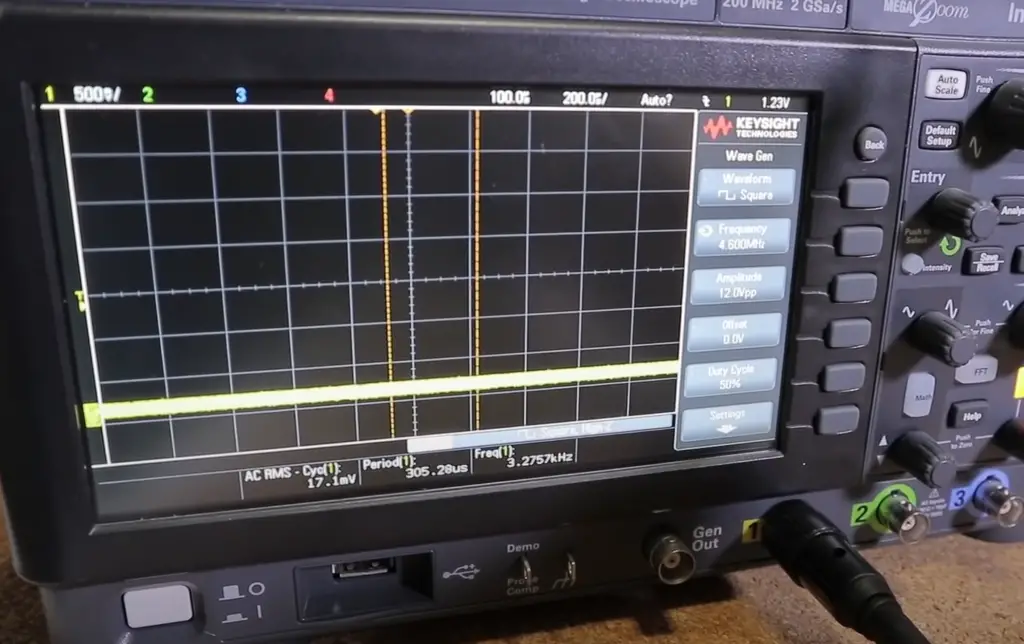
Analog Oscilloscope vs. Digital Oscilloscope
There are actually two types of oscilloscopes, analog and digital.
They can be used to measure voltage, current, frequency, phase, and many other characteristics of a signal. They consist of two main components: the oscilloscope itself and probes. The oscilloscope is where the measurements are displayed in graphical form on the screen while the probes are connected to the circuit being tested and allow the signals to be transferred from the circuit into the scope.
Analog scopes display a waveform (or trace) on their screen which is created by converting an analog electrical signal into digital data points (also known as samples). The samples are then plotted onto a graph using either dots or lines. This graph then provides a visual representation of the signal being measured.
Analog oscilloscopes are used in many industries including automotive, aerospace, manufacturing, and electronics. They can be used to troubleshoot circuit boards, analyze signal characteristics, debug errors in electrical systems, and more. Many analog scopes also offer features such as adjustable voltage thresholds, color-coded cursors for making measurements quickly and accurately, persistence mode which allows patterns to remain on screen even after the signal has been removed from the circuit, and more.
A digital oscilloscope (also known as a digital storage oscilloscope) is an electronic testing instrument used to measure electronic signals. It works similarly to an analog oscilloscope, but uses digital technology instead of analog circuitry and components. Digital Oscilloscopes feature sophisticated triggering capabilities, automatic measurements, data logging, computer connectivity, advanced math functions and much more. They are extremely versatile instruments for troubleshooting and analyzing complex circuit behavior in research laboratories or production test environments.
Digital Oscilloscopes offer several advantages over traditional analog oscilloscopes. For example, they are able to store waveforms for later viewing and analysis without the need for additional components such as chart recorders or photographic paper. Additionally, they provide higher accuracy due to the ability to sample data at much higher resolution than analog oscilloscopes, allowing for more detailed analysis of waveforms. Finally, digital oscilloscopes are much easier to use than analog scopes and offer a wide variety of features including auto-set, automatic measurements, large color displays and user configurable settings.
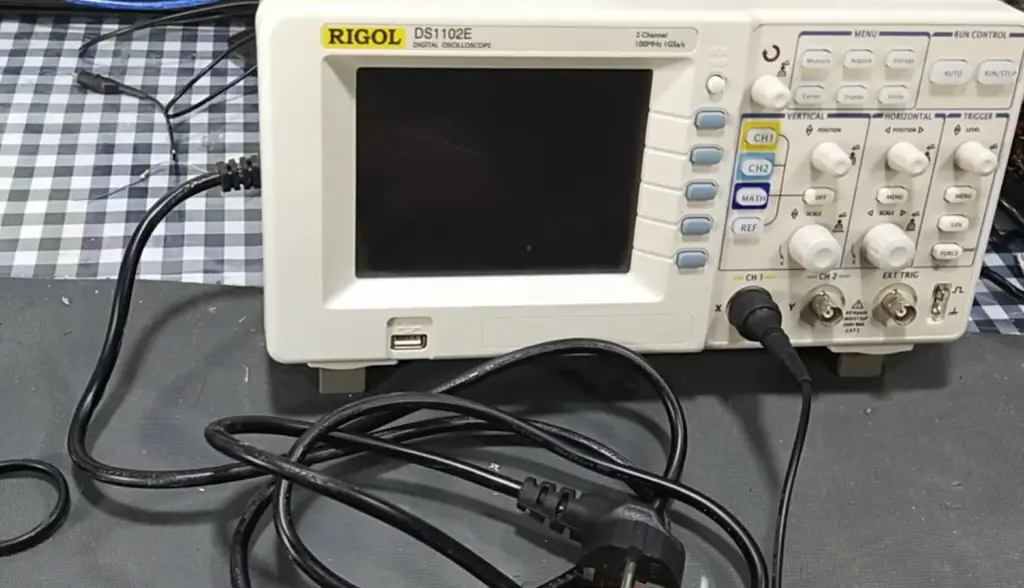
Digital Oscilloscopes are also ideal for capturing transient events such as glitches or spikes that may be too fast to measure with other instruments. Additionally they can provide real-time bandwidths in excess of 800 MHz which enable them to capture high frequency signals accurately. As technology continues to progress, these instruments will continue to become even more powerful and versatile. Digital oscilloscopes are an essential tool for anyone involved in electronic design and testing. [1], [2]
Oscilloscope vs Multimeter
Very often when considering the best tool for testing and troubleshooting an electronic circuit, one of the first questions that arises is whether to use an oscilloscope or a multimeter. A multimeter is a device used to measure electrical parameters such as voltage, current, and resistance. It can be used for both DC and AC measuring applications. Both tools offer unique advantages and disadvantages, so it really depends on the application.
Accuracy
The primary difference between an oscilloscope and a multimeter is their accuracy. Oscilloscopes are able to measure waveforms at a bigger scale and accuracy compared to multimeters. The sampling rate of a digital oscilloscope is much higher than that of a multimeter, so it can capture signals with higher frequency and amplitude. However the accuracy of the measurement is typically lower than that of a multimeter. Multimeters, on the other hand, measure individual electrical parameters at higher accuracy, but are limited to measuring just one parameter at a time.
Display
Another key difference between an oscilloscope and a multimeter is the display of information. An oscilloscope displays the signal in graphical form, while a multimeter displays numerical values. This makes it easier to see patterns or trends in signals that would otherwise not be recognized when viewing only numeric values. Additionally, oscilloscopes can trigger on specific events, allowing them to capture data at just the right moment for troubleshooting or debugging purposes.
Portability
Another major difference between oscilloscopes and multimeters is their portability. Oscilloscopes are generally large, bulky instruments that require a dedicated bench or table for setup. They usually come with additional cables and accessories which add to the overall size of the instrument. Multimeters, on the other hand, are relatively small and lightweight, making them much more portable than an oscilloscope. This makes them ideal for fieldwork or troubleshooting in tight spaces where an oscilloscope may not be practical.

Ease of use
The last major difference between oscilloscopes and multimeters is the ease of use. Oscilloscopes are generally more difficult to operate than multimeters because they require the user to interpret waveforms in order to measure electrical parameters. They also offer a wide variety of features, such as automatic measurements, data logging, computer connectivity, advanced math functions and much more. Multimeters on the other hand are much simpler to understand and operate – their displays typically show just one parameter at a time which makes it easy for users to interpret readings quickly and accurately. [3]
What Does an Oscilloscope Measure
By now you should have a good idea of what an oscilloscope can measure. But since you have clicked on this article, it’s clear you want to find out what an oscilloscope measures, we are going to discuss them in this section.
Frequency
Frequency is one of the most important elements when it comes to using an oscilloscope. Frequency is a measure of how many times something happens over a period of time, usually measured in Hertz (Hz). On an oscilloscope, frequency is typically measured by counting the number of cycles that occur within a set amount of time.
The signal being measured with an oscilloscope will often vary in frequency depending on what type of signal it is. For example, AC power signals usually have very low frequencies around 50 or 60 Hz, while radio waves may have much higher frequencies well into the gigahertz range. When measuring these different signals, it’s important to use the correct settings for your oscilloscope so that you can accurately measure the frequency.
The frequency your oscilloscope can measure will depend on its bandwidth, which is the maximum frequency it can accurately measure. Most oscilloscopes have a bandwidth rating somewhere between 50MHz and 2GHz. This means that any signal with a frequency higher than the oscilloscope’s bandwidth will not be able to be accurately measured.
Voltage
An oscilloscope measures the voltage of a waveform. Voltage is a measure of the potential energy of an electrical charge per unit, measured in volts. When you connect your oscilloscope to a circuit or device, it measures the voltage across its terminals and displays that information as an electronic signal on the screen. X-axis on the oscilloscope screen represents time, while Y-axis represents voltage. The displayed waveform gives you a good insight into the behavior of your circuit or device.
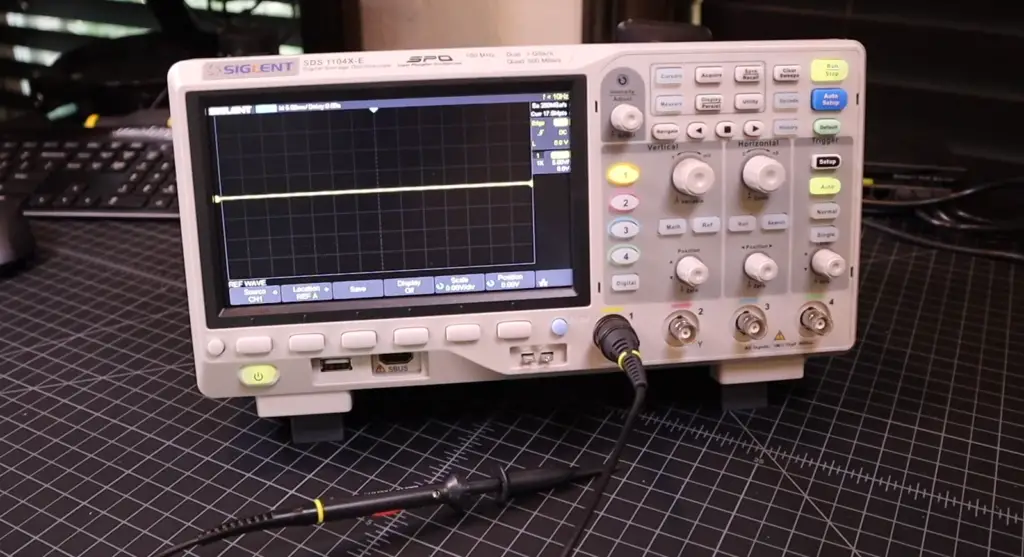
When viewing a signal with an oscilloscope, it is possible to find the peak-to-peak voltage by multiplying the V/div setting by the number of divisions visible on the screen. It is also possible to measure frequency using an oscilloscope, as well as amplitude (the height of each wave). Additionally, when working with alternating current or AC signals, it is important to consider both positive and negative values for calculations.
Amps and Watts
An oscilloscope can measure the amperage and wattage of an electrical current. It can also measure voltage, but this is not its primary purpose. Amps measure the rate at which electricity flows through a conductor, while watts measure the power consumed by a device or circuit. An oscilloscope has inputs for both amps and watts, allowing it to display a graph showing how much electricity is being used in real-time.
This means you can actually use an oscilloscope as a power consumption tool. By connecting it to an electrical device and monitoring the amperage and wattage, you can determine how much energy it’s consuming. This is especially useful for troubleshooting malfunctioning electronics or optimizing energy efficiency in industrial applications.
Sound
An oscilloscope can measure sound, too.
In order to measure sound with an oscilloscope, you need to convert it into an electrical signal first. This conversion can be done using a microphone or other transducer that converts acoustic energy into electrical signals. Once converted, the electrical signal can then be displayed on the oscilloscope’s time and voltage axes.
The result will look like a pattern made of repeating peaks and troughs (familiarly known as sine waves). On the oscilloscope screen, these patterns represent different frequencies of sound; higher frequency sounds have shorter wavelengths while lower frequency sounds have longer wavelengths. The amplitude of each peak and trough is the sound’s loudness, and this can be adjusted with the oscilloscope’s vertical sensitivity control.
Capacitance
Another of the parameters an oscilloscope can measure is capacitance, which is the ability of an electronic component to store energy in an electric field. Capacitance can be measured with an oscilloscope by measuring the time it takes for a signal to charge across a capacitor.
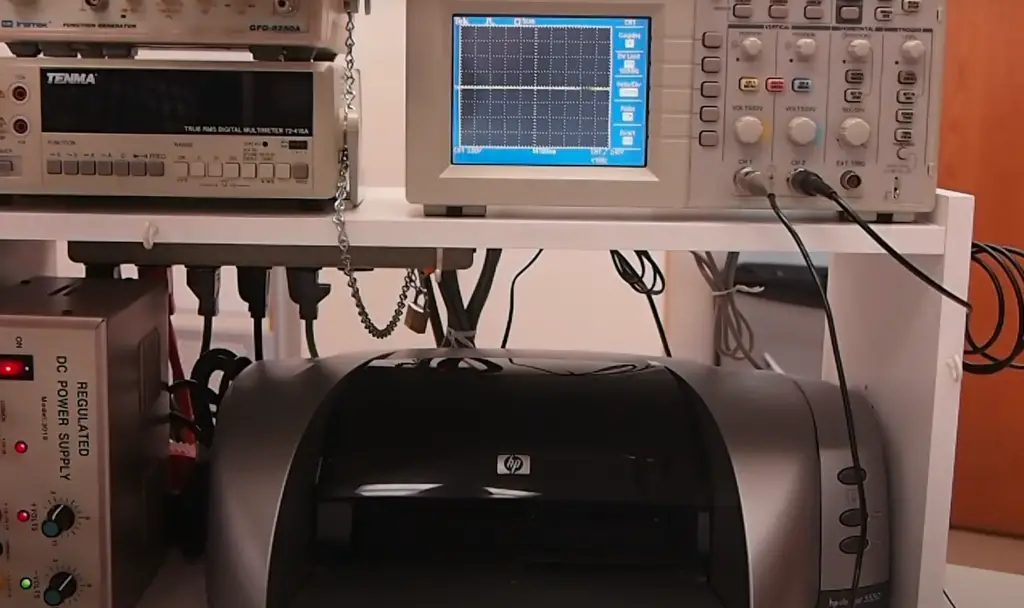
Inductance
Inductance is a property of electricity and magnetism, in which current flowing through an electrical circuit will generate a magnetic field. This magnetic field can then induce a voltage in the same or nearby circuit elements. Inductance is determined by voltage or frequency.
When it comes to oscilloscopes, inductance measurements are important for determining how much energy is stored in the electromagnetic components of a circuit. Oscilloscopes allow you to measure the amount of inductance being present by displaying the voltage induced within the element with respect to time on its screen. [1], [2]
FAQ
Can an oscilloscope measure frequency response?
Yes, oscilloscopes can measure frequency response with the help of a device called an FFT (Fast Fourier Transform) analyzer. The FFT analyzer uses digital signal processing techniques to convert a time-domain signal into its corresponding frequency domain representation. This allows users to gain insight into the frequency content of their signals and observe frequencies outside the bandwidth of traditional oscilloscopes. When measuring system responses, such as resonance or speaker tuning, this capability can be invaluable.
What is the main purpose of an oscilloscope?
The main purpose of an oscilloscope is to measure and analyze the electrical signals that are generated by various electronic devices. Oscilloscopes can be used to measure voltage, current, frequency, or even amplitude. It provides a visual representation of these values in the form of waveforms which can then be studied and analyzed. By studying the waveforms, engineers and scientists can gain insights into how different components interact with each other or are affected by changes in external factors.
Does the oscilloscope measure current or voltage?
The oscilloscope measures voltage. It is designed to measure the potential difference between two points in a circuit, usually one point grounded and one point connected to the signal of interest. The oscilloscope can also detect current if it is converted into a voltage through an appropriate resistor or current-voltage converter.
Does an oscilloscope measure AC and DC?
Yes, an oscilloscope can measure both AC and DC signals. The most basic type of oscilloscope is a single-channel device that measures voltage over time. This type of oscilloscope can be used to measure both AC and DC voltages.
The more advanced versions include multiple channels which allow for the simultaneous measurement of multiple waveforms, as well as specialized features such as auto-ranging and automated triggering. These more advanced types of oscilloscopes are also capable of measuring both AC and DC signals, although they are generally designed to focus on one or the other depending on their intended use.
In addition to measuring AC and DC signals, oscilloscopes may also be used to measure other parameters such as current, frequency, capacitance, resistance, and many others. However, for the most part oscilloscopes are used to measure voltage due to its ability to provide a clear view of waveforms in a relatively short amount of time.
What does an oscilloscope measure sound?
In order to measure sound, the oscilloscope must be configured properly. Generally speaking, it is necessary to set up an input for the signal and an output for the data visualization. The input can be a microphone or other audio device connected through an amplifier, while the output is usually either a CRT (Cathode Ray Tube) screen or one of many modern digital displays. Once these connections are established, the oscilloscope will graphically represent sound waves in terms of their frequency and amplitude over time. This allows users to analyze their sound signals to identify issues such as buzzing or distortion, as well as make sure that they are producing sounds with desired characteristics like smoothness and clarity.
By exploring sound waveforms with an oscilloscope, users can gain greater insight into their audio signals and diagnose any potential problems. Furthermore, they can get creative and experiment with adjusting levels and frequencies to create interesting sonic manipulations. All in all, the oscilloscope is a versatile tool for measuring sound that allows for both practical and artistic experimentation.
Useful Video: What’s an OSCILLOSCOPE?
Conclusion
An oscilloscope is a versatile and powerful tool that can be used to measure a variety of electrical signals. It is a great way to troubleshoot, diagnose and monitor circuits, as it can display the behavior of an electrical signal over time. Oscilloscopes are particularly useful for measuring voltage levels, frequency, and amplitude. In addition to this, they can also be used to detect glitches or pulses in digital circuits, evaluate the performance of RF circuits and analyze the waveforms generated by complex analog circuitry.
In this article, we have discussed the basics of what an oscilloscope measures and how it works. We have also looked at some of the advantages that oscilloscopes offer over other test instruments. Finally, we have explored the different types of oscilloscopes available and highlighted the best features to look out for when choosing a model.
When selecting an oscilloscope for your needs, you should consider factors such as bandwidth and sample rate requirements, number of input channels required and other features such as record length support and trigger capability. By understanding what an oscilloscope measures, you will be able to make an informed decision on which oscilloscope is best suited for your application.
Thanks to its versatility and accuracy, the oscilloscope is an essential tool in any electronics laboratory. With the right knowledge and skills, you can harness the power of this instrument to measure a variety of signals with precision. We hope that this guide has provided you with enough information about what an oscilloscope measures so that you will be able to choose the correct model for your needs.
If you have any further questions or would like more assistance selecting the right oscilloscope for your application, please don’t hesitate to contact us! Our experienced team of experts will be more than happy to provide all the advice and guidance necessary to help you find the perfect oscilloscope for your application.
Thanks for reading! We wish you luck on all your future testing and measurement endeavors!
References
- https://learn.sparkfun.com/tutorials/how-to-use-an-oscilloscope/all
- https://www.circuitsgallery.com/what-does-an-oscilloscope-measure/
- https://www.circuitsgallery.com/oscilloscope-vs-multimeter





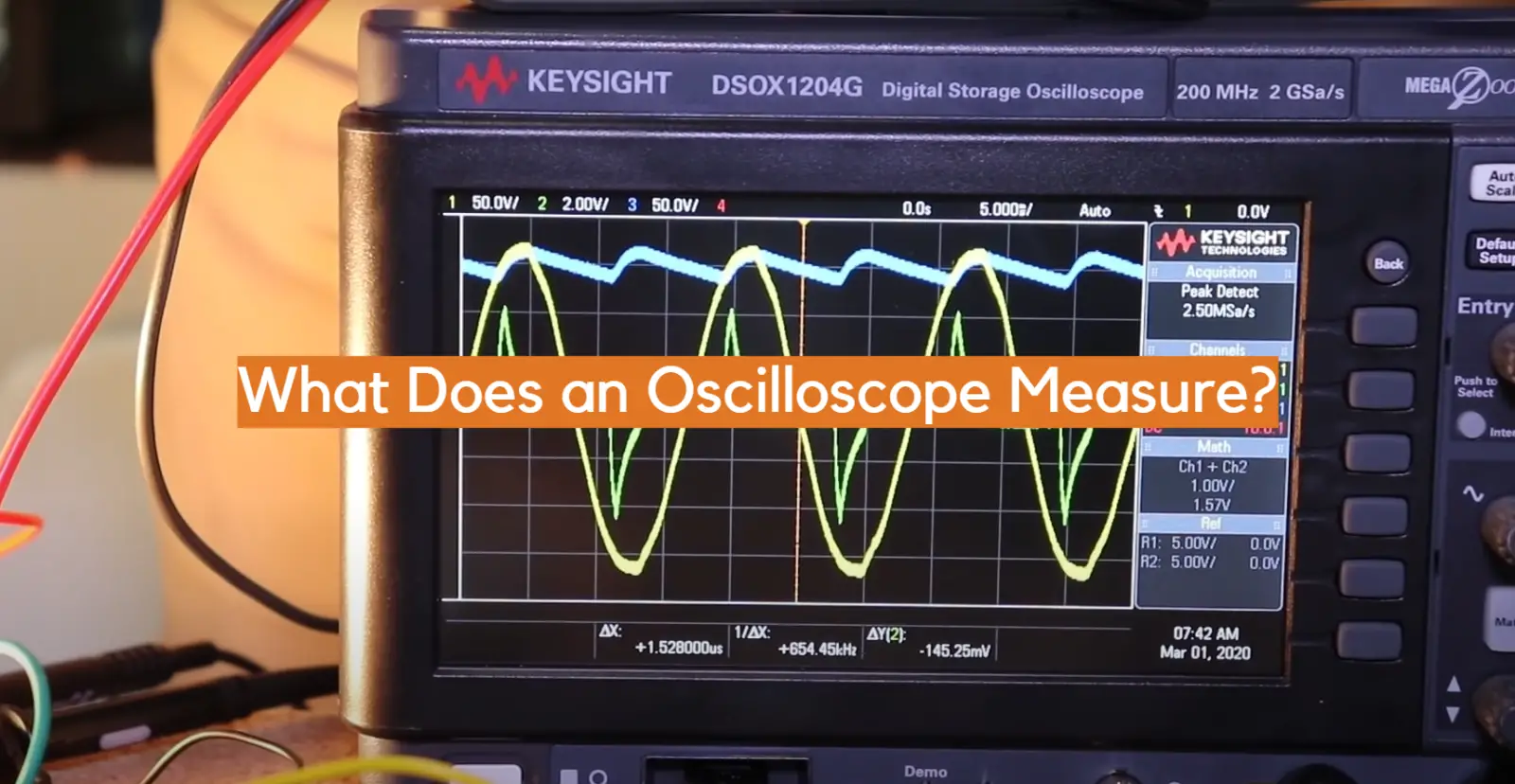






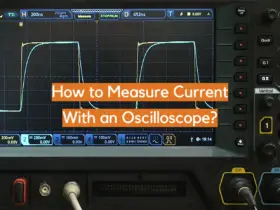

Leave a Reply